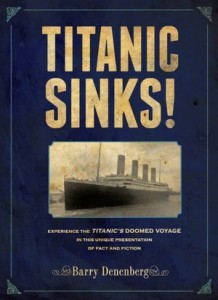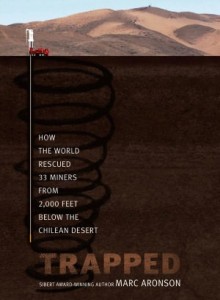Everybody likes stories. But a significant number of bodies prefer their stories to be true, or at least factual.
I’ve long heard it rumored among librarians and classroom teachers that if boys have to read, they’re often more likely to reach for a non-fiction book than a novel. It’s an inclination that persists into adulthood, if polls and surveys are to be believed. In my free reading (i.e., not what I do for this blog) I lean toward non-fiction myself these days, mostly because there’s so much I want or feel the need to know. But I’ve been told, by my agent and others, that non-fiction is the midnight shift of children’s publishing. Why, when about half the minor population tends to prefer it? This librarian has a clue, but lots of teachers and publishers don’t. Still, good non-fiction books get published, and some of them get the recognition they deserve. Today I want to call your attention to two books about famous disasters (always a popular subject). And next Friday, two books of practical and impractical skills.
Titanic Sinks! by Barry Denenberg. Viking, 2011, 72 pages (large format). Age/interest level: 9-up.
At age 12 I became the proud owner of a copy of The Texas News, which told Texas history in the form of fictional newspaper pages. My 7th grade classroom had a copy, and I was enthralled enough to ask for it for Christmas. It’s still on my shelves, which may be why I’m already inclined Titanic Sinks!, which purports to be a series of news reports filed by correspondent S. F. Vanni of the fictional journal, Modern Times. Vanni was privileged to join the passenger list of the great ship’s maiden voyage in order to report on the splendid appointments and impressive statistics of White Star Lines’ latest stunning achievement. We share his breathless approval of the on-board amenities in first, second, and third class, marvel at a staff so complete it includes “boot stewards” and “plate stewards,” and visit the gym and the pool. Vanni has an eye for telling details, such as how rivets are installed. Which will prove of some significance later.
For, as we all know, the unsinkable ship proved tragically vulnerable, as did the arrogance and grandiosity of some of the key men associated with her. My lips are sealed about Vanni’s fate, but less than half the human complement of the Titanic survived her maiden voyage. The story of her last hours marks three major shifts: first, the original impact of the iceberg to the early reassurances and the effort to maintain a party atmosphere with the eight man orchestra. Next, confusion reigns as the minutes pass and the crew struggles to untangle the lifeboats from the davits that secure them. Finally, resignation and courage in the face of the inevitable, as an overwhelming number of male passengers and all but one of the staff go down with the ship (in striking contrast to a more recent maritime disaster).
The news doesn’t end there: follow-up reporting includes an interview with Captain Arthur Rostrum of the rescue ship Carpathia–“a God-fearing man [who] does not smoke, drink or curse”—and the tragic fate of ship builder Bruce Ismay and midnight lookout Frederick Fleet. This April marks the centennial of the Titanic disaster, and the story’s power to amaze and fascinate has not dimmed. Expect a return of Rose and Jack to movie theaters (in 3-D!) but Titanic Sinks! is a better way to commemorate the occasion.
 Trapped: How the World Rescued 33 Miners from 2000 Feet Below the Chilean Desert, by Marc Aronson. Atheneum (Simon & Shuster), 2011, 134 pages. Age/interest level: 10-up.
Trapped: How the World Rescued 33 Miners from 2000 Feet Below the Chilean Desert, by Marc Aronson. Atheneum (Simon & Shuster), 2011, 134 pages. Age/interest level: 10-up.
While the Titanic is shrouded in the mists of time, the saga of the Chilean miners is only a year old, and some young readers may remember their parents keeping vigil with the rest of the world as all 33 trapped miners were miraculously rescued. The title of Aronson’s book clues us that he’s going to take a secular approach, instead of the spiritual language that came more and more to characterize the story (see, for example, here and here). But he gives faith some credit for sustaining the miners during their ordeal, and it’s hard not to marvel at the combination of ingenuity, perseverance, and Providence that combined to wrest these men from the deep clutches of earth. More than a narrative, it’s also an excursion into the history, geology, and logistics of mining, creating a well-rounded context in which to appreciate this accomplishment.
The story is told in two parts. The first part takes place before contact was established with the miners, before anyone even knew they were alive. The narrative alternates between “Below,” where the men assemble in the underground shelter and organize themselves for survival, and “Above,” where word goes out and experts from all over the world rush to the Chilean desert with their equipment. Drilling down to the shelter is a hit-or-miss enterprise, with time running out for miners and failure becoming more likely . . . until the moment when a diamond-studded drill bit crashes through the roof of the shelter. Jose Ojeda attaches a note: “We are in the shelter and are well, the 33.”
“The tears everyone was holding back flipped upside down and came out as happy screams, wild leaps, crazy dances. Some genius gave the gathering place of the relatives the perfect name: Campamento Esperanza, ‘Camp Hope.’” After that, Part Two is a bit of an anticlimax, but the account of the three major plans to get those boys out of the ground—and which one succeeded–is absorbing and just technical enough.
The message is this: “the most important reason the men came home safe was how they behaved when they were totally alone. They did what they could, even though they had no idea if it would make any difference. The lost men trusted in one another and in their faith, and made the best of every moment . . . From the bottom of the earth they set an example for us.” True to a point, and a good opportunity to draw a distinction between faith in faith and faith in God (read Job 28 for context). Even those who followed the story closely will find something new here.
Looking for books for boys? You can start with Stalking the Elusive Boy Reader. And if your boy or girl loves history, you should meet Cheryl Harness, here and here. Also see Columbus and the Founding of Our Nation. And come back next Friday for more nonfiction ideas.
Support our writers and help keep Redeemed Reader ad-free by joining the Redeemed Reader Fellowship.
Stay Up to Date!
Get the information you need to make wise choices about books for your children and teens.
Our weekly newsletter includes our latest reviews, related links from around the web, a featured book list, book trivia, and more. We never sell your information. You may unsubscribe at any time.
We'd love to hear from you!
Our comments are now limited to our members (both Silver and Golden Key). Members, you just need to log in with your normal log-in credentials!
Not a member yet? You can join the Silver Key ($2.99/month) for a free 2-week trial. Cancel at any time. Find out more about membership here.
1 Comments
Leave a Comment
You must be logged in to post a comment.


I love the work being doing in non-fiction for kids today. There’s no reason why it shouldn’t be as interesting or even more interesting to budding readers than fiction.
Did you follow the link at the bottom of the librarian’s page? To Guys Read? I was very much amused that the header art seemed to be a picture of some port-o-potties on a truck. I can’t help thinking Jon Scieszka had something to do with that.